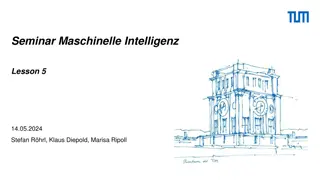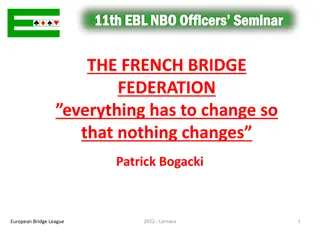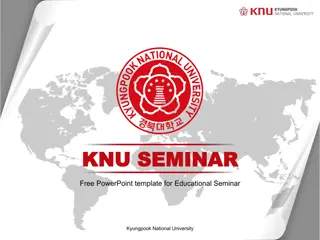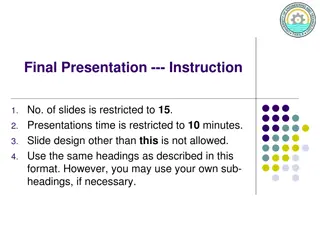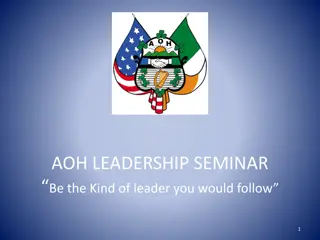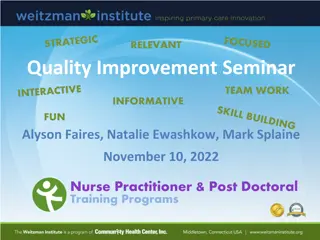Seminar presentation
This project focuses on developing a robot-assisted steady ultrasound imaging system using deep learning techniques. The aim is to address challenges in imaging real tissue with non-random scatterer configurations, where traditional models may fall short. By employing Gaussian Process and motion estimation methods, the project proposes a novel approach to enhance ultrasound imaging accuracy. The methodology involves training sparse Gaussian process regression to provide probabilistic predictions, enabling a more precise estimation of tissue micro-structure. The project explores enhancing image quality and accuracy in ultrasound imaging for improved medical diagnostics.
Download Presentation

Please find below an Image/Link to download the presentation.
The content on the website is provided AS IS for your information and personal use only. It may not be sold, licensed, or shared on other websites without obtaining consent from the author.If you encounter any issues during the download, it is possible that the publisher has removed the file from their server.
You are allowed to download the files provided on this website for personal or commercial use, subject to the condition that they are used lawfully. All files are the property of their respective owners.
The content on the website is provided AS IS for your information and personal use only. It may not be sold, licensed, or shared on other websites without obtaining consent from the author.
E N D
Presentation Transcript
Seminar presentation Group 7 Robot-assisted steady ultrasound imaging enabled by deep learning Tian Xie
Project Robot-assisted steady ultrasound imaging enabled by deep learning
Papers 1. Laporte, C., & Arbel, T. (2011). Learning to estimate out-of-plane motion in ultrasound imagery of real tissue. doi://doi.org/10.1016/j.media.2010.08.006 2. Salehi, R. M., Sprung, J., Bauer, R. & Wein, W. (2017). Deep Learning for Sensorless 3D Freehand Ultrasound Imaging. In: Medical Image Computing and Computer-Assisted Intervention MICCAI 2017. MICCAI 2017.
Learning to estimate out Learning to estimate out- -of of- -plane motion in ultrasound imagery of real tissue in ultrasound imagery of real tissue Laporte, C., & Arbel, T. (2011) plane motion
Summary Problems to solve: Micro-structure of real tissue may not be densely packed as phantoms and may exhibit non-random scatterer configurations US signals decorrelate more slowly and differently with different medium Nominal decorrelation model from the reference phantom cannot provide accurate estimation for real tissue Solution: Gaussian Process
Approach Training: Motion estimation:
Approach Decorrelation curve is represented by a Gaussian function of distance Medium dependent Stretching of the curve along axis Find out the relationship of deviation between two models
Approach Features in the calibration phantom nominal curve Features in other medium
Approach -- Training Sparse Gaussian process regression(Snelon and Ghahramni, 2006) Features: When the regression is learned, Two corresponding image patches A global estimate: A locally adapted piecewise curve: Estimate: Probabilistic predictions: mean and variance of
Approach Motion estimation A rigid body transformation then fitted to those patch-wise estimations by least-median-of-squares (Rousseeuw and Leroy, 1987)): (x,y) : center of patch in the image z: estimated elevational distance
Experiment Data Acquisition Synthetic US images of speckle phantom (nominal curve) Synthetic US data sequences in 15 virtual phantoms (training data sets) US scans of pork tenderloin, turkey breast and beef brisket Images: 0.01 0.1 mm elevational intervals Patches around 50x30 pixels
Results Base-methods: Direct use of nominal speckle decorrelation curve Speckle detection (Prager et al, 2002) Locally adaptive heuristic method (Gee et al, 2006)
Deep Learning for Deep Learning for Sensorless Freehand Ultrasound Imaging. Freehand Ultrasound Imaging. R. Prevost, M. Salehi, J. Sprung, R. Bauer & W. Wein. (2017) Sensorless 3D 3D
Summary Objectives: Estimate the transformation between two B-mode ultrasound images Realize sensorless 3D freehand ultrasound imaging Problem: Out-of-plane motion estimation Current models (developed on fully developed speckles) cannot generalize to real clinical data Solution: End-to-end deep learning to circumvent the problems
Experiments Equipment: 128-element probe at 9MHz, 256 scan-lines Depth 5cm, focus 2cm B-mode images resampled with an isotropic resolution of 0.3mm Optical target on the probe (accuracy around 0.2mm) Dataset: 20 sweeps (7168 frames) on a BluePhantom US biopsy phantom 88 in-vivo sweeps (41869 frames) on forearms 12 in-vivo sweeps (6647 frames) on lower legs
Critique Cons: The paper sees CNN an analogy for speckle correlation, but I doubt the network is actually trained on anatomical features. Pros:





